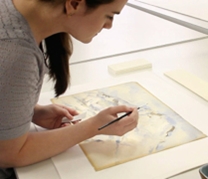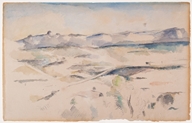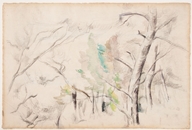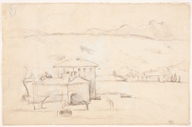Grant Spotlight | April 1, 2015
Share This
 |
|
Recipient: Barnes Foundation Grant: 2013 Museums for America Grant Pictured: A conservator works on one of the Cézanne watercolors. Click image for a larger view. |
|
Project Contact: |
“Every conservation project adds more to the field’s knowledge. It’s very satisfying to know that
these works are being well cared for, not only to honor the artists, but also to allow future
generations to appreciate their work.”
—Barbara Buckley, Senior Director of Conservation
and Chief Conservator of Paintings
Preserving—and Rediscovering—Works of Art
Conservator Barbara Buckley of the Barnes Foundation was caught by surprise when she got the call from the Conservation Center in Philadelphia, where a treatment project had recently begun on works of art from the Foundation’s permanent collection. “We received a phone call from the Conservation Center for Art and Historical Artifacts (CCAHA) telling us of a discovery. Upon hearing the news, the chief curator and I were excited and anxious to see what they had found,” she said. In the course of the conservation treatment, two Cézanne sketches had been uncovered.
With help from an IMLS grant, the Barnes Foundation had engaged the Conservation Center for Art and Historical Artifacts in Philadelphia to conserve 22 watercolors, gouache, and pastels on paper in its permanent collection. This included five works by Paul Cézanne, five by Pablo Picasso, nine by Paul Klee, two by Edgar Degas, and one by Pierre-Auguste Renoir. The works were treated to mend tears, remove residues of old adhesives, re-house the works with archival quality materials, and provide glazing to filter ultraviolet radiation. During the project, frame conservation treatment was also completed.
The Cézanne watercolors also had a brown acidic paper adhered to the paper overall on the verso. “Part of the treatment was to remove the acidic paper from the verso,” said Buckley, who is Senior Director of Conservation and Chief Conservator of Paintings. “We had no suspicion that we would find anything underneath.”
Artist Insights
But when conservators removed the brown paper, they discovered two additional works by Cézanne—one graphite drawing and one watercolor sketch. The drawing and sketch were on the reverse sides of two works depicting landscapes of southern France, The Chaîne de l'Étoile Mountains and Trees, normally on view in Room 20 of the Barnes’s Collection Gallery.


Paul Cézanne (French, 1839–1906). Recto (left): The Chaîne de l'Etoile Mountains (La Chaîne de l'Etoile avec le
Pilon du Roi), 1885–1886. Watercolor and graphite on wove paper; Verso (right): Unfinished Landscape, undated.
Watercolor and graphite on wove paper, Sheet: 12 3/8 x 19 1/8 in. (31.4 x 48.6 cm). BF650. Photo © 2015
The Barnes Foundation. Click either image for a larger view.


Paul Cézanne (French, 1839–1906). Recto (left): Trees (Arbres); c. 1900, possibly earlier. Watercolor and graphite
on laid paper; Verso (right): Houses in Landscape with the Pilon du Roi, undated. Graphite on laid paper,
Sheet: 12 3/16 x 18 11/16 in. (31 x 47.5 cm). BF655. Photo © 2015 The Barnes Foundation.
Click either image for a larger view.
It is probable that the sketches have not been seen since the early 20th century, prior to Barnes Foundation founder Dr. Albert C. Barnes’s purchase of the works in 1921 from Leo Stein. “The sketches provide new opportunities to learn about Cézanne’s artistic process and highlight the significance of collections stewardship,” said Buckley.
“This discovery shows how many more discoveries we are bound to find,” said Buckley. Indeed, from the distinctive houses and mountains featured in the graphite drawing, Denis Coutagne, president of the Paul Cézanne Society in Provence, France, conducted research to find the exact spot Cézanne was standing on when he drew the piece.
Enhancing Study and Stewardship
The project has provided the conservation department the opportunity to take a closer look at these works and department staff have begun to study the materials of the artist, including analysis of the pigments and papers used.
Although the Barnes collection is a permanent installation, left according to the founder’s vision for art education, the Barnes will hold a special in-house display, Cézanne Uncovered: Two Sketches Revealed through Conservation, from April 10 to May 18, 2015. This will be a unique opportunity for visitors to see the two newly revealed works in double-sided frames before they are returned to their places in the gallery. “The installation is an opportunity to share some of the behind-the-scenes excitement that we have as we study the works in our collection and make new discoveries through conservation,” Buckley said.
